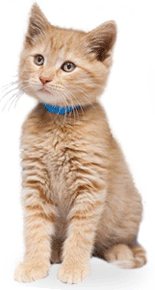Preparing Your Home and Supplies
Before you bring your new cat or kitten home, it is important to “kitty proof” (for his safety as well as that of your belongings) and to purchase a few basic supplies. Here is a quick check list to get you started:
- Prepare a safe room for your new cat, such as a bathroom or small spare bedroom. Place the litter box at one end with the food, water dishes and bed at the other. Allow your cat lots of time to adjust. Keep the cat in this safe place for the first several days, and then continue to return him to this room initially when you're away and overnight. (If it is your bathroom, remember to close the toilet lid!)
- Many plants are poisonous to animals, so do a thorough check of your home before bringing your new cat home. Here is a list of some of the most common household plants that are toxic: Amaryllis, Azalea, Baby’s Breath, Bird of Paradise, Calla Lilly, Cyclamen, Daffodil, Dieffenbachia, Easter Lily, Eucalyptus, Mistletoe, Narcissus, Oleander, Peace Lily, Primrose, Philodendron, Tiger Lily, and Tomato plant.
- Help reduce potential human allergies by getting a good HEPA air cleaner and vacuuming frequently.
- Remember, cats are naturally curious, like to explore and can get on top of most anything. It is a good idea to put away breakables that may be knocked off a shelf by an exploring kitty. It may be as easy as closing a door to a room.
 Supplies
Supplies
- Litter box and Litter: There are many different kinds of litter to choose from, but in studies, most cats prefer non-scented fine clumping litter.
- Food: We recommend feeding a high-quality dry food supplemented with a small amount of canned food daily.
- Food and Water Dishes: Avoid plastic dishes; they harbor bacteria. Make sure food and water dishes aren’t placed near the litter box.
- Safety Collar and ID Tag: Even indoor-only kitties should wear a collar and ID tag.
- Nail Clippers and Other Grooming Supplies: A flea comb and a brush are needed to keep your cat's coat healthy. Hairball medication should be in your supply drawer if your cat has medium to long hair.
- Safe Toys: Cats love to chase and hunt down toys. Avoid those with small parts that can break off and be ingested. Also avoid yarn, string, and curling ribbon as these will cause problems inside your cat’s digestive tract if swallowed.
- Scratching Post: Give your cat an appropriate place to do what comes naturally. Scratching not only helps kitty shed the sheath of his claws, but also marks territory. Try a post that will allow your cat to get a full stretch. Post materials vary (rope, carpet, wood) so find one your cat likes. Even declawed cats should have access to a scratching post to stretch, scent mark, and relieve stress.
